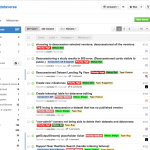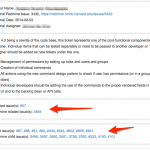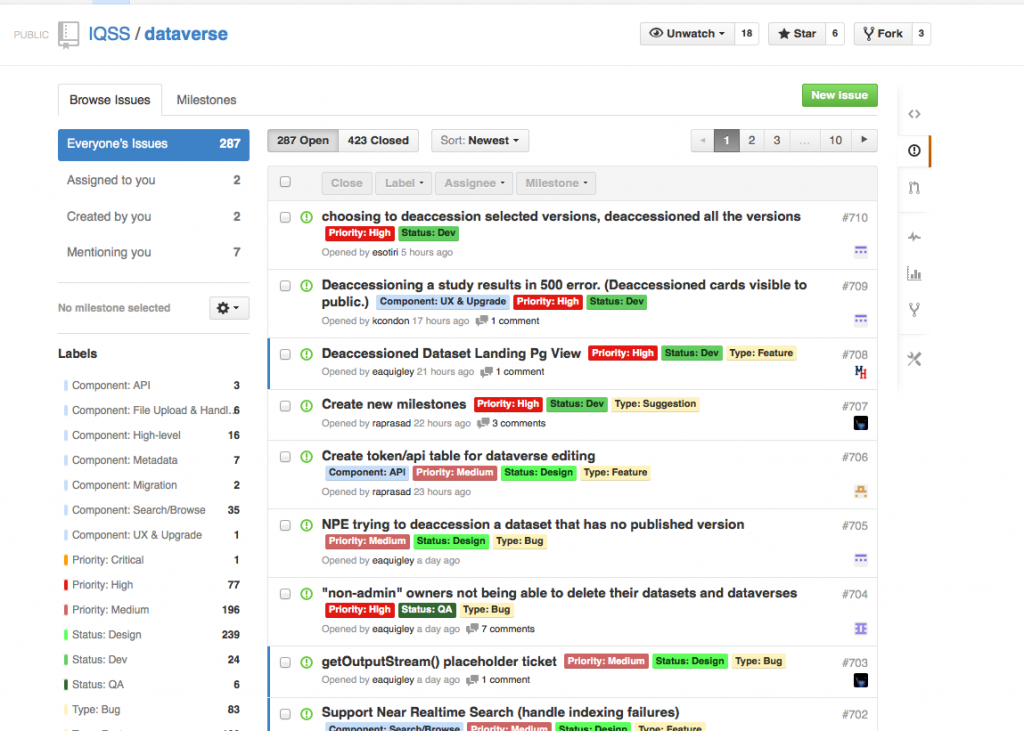Recently, we moved from Redmine to GitHub Issues for sake of transparency/consolidation.

Taking advantage of the RedMine and GitHub APIs, we wrote an unpolished/try-to-get-the-job-done-by-wednesday python program redmine2github to make the switch. The process was roughly as follows:
- Copy each redmine ticket to an individual JSON file. Information included:
- Comments (journals)
- Relations
- Child Tickets
- etc
- Manually created the following mappings. (All mappings are optional with the program)
- Name Map between Redmine and GitHub users. This allows translation of Issue creators, Commenters, and Assignees
- Label Map to translate Redmine attributes to GitHub labels. Note: the first column, “redmine_type” is not used by the program–it’s a reference for humans. The file/program are “dumb” and don’t look for name clashes in the “redmine_name” column.
- Note: By repeating columns 3 and 4, 2 or more “redmine_name”s may be translated to the same label. In the sample file, the first three Redmine Names: “New”, “In Review”, and “In Design” are all moved to the label “Status: Design”
- IMPORTANT: If a label map is used, any “redmine_name” not on the map will be ignored. If a label map is NOT used, the “redmine_names” will be made into labels–but with no color attribute.
- Milestone Map to translate Redmine “fixed_version” to a GitHub milestone. This works similarly to the Label Map with an import distinction below:
- IMPORTANT: Differently from the label map, any Redmine “fixed_version”s not found in the milestone map, will be created in GitHub.
- Ran the issue migration (mm.migrate_issues()) several times on newly created test repositories–that were then deleted. This helped work out bugs, etc.
- Ran the issue migration against the real repository (this will “spam” users if you use a name map)
- The migration creates an issue mapping file with JSON that maps { redmine issue number : github issue number }
- Part of the mapping file:
{"4096": 647, "4097": 648, "4098": 649, "4100": 650, "4101": 651, "4102": 652, "4103": 653, "4104": 654, "4105": 655, "4106": 656, "4107": 657, "4108": 658, "4109": 659, "4110": 660, "4111": 661, "4112": 662, "4113": 663, "4114": 664, "4115": 665, "4116": 666, "4117": 667, "4118": 668, "4119": 669, "4120": 670, "4121": 671, "4122": 672, "4123": 673, "4124": 674, "4125": 675, "4126": 676, "4127": 677, "4128": 678, "4129": 679, "4130": 680, "4131": 681, "4132": 682, "4133": 683, "4134": 684, "4135": 685, "4136": 686, "4137": 687, "4138": 688, "4139": 689, "4140": 690, "4141": 691, "4142": 692, "4146": 693, "4148": 694, "4149": 695, "4150": 696, "4151": 697, "4153": 698, "4154": 699, "4156": 700, "4157": 701, "4160": 702, ....}
- Run migration part #2 (#mm.migrate_related_tickets()) which updates the GitHub Issue descriptions with links to related and child tickets as defined in Redmine.
- Run a script to update the Redmine tickets with a link to the new GitHub Issue.
The final migration, runs 1&2, took about 7 minutes for 700+ tickets. The results:
Overall, it worked fine. We have tweaked the labels since the initial mapping.


A team I work with is considering making the same move. Are there any redmine features you will miss? I’ve seen older articles (3+ years) suggesting the following cons of moving to GitHub:
…No issue relations
…No sub-tasks
…No custom statuses
…No custom form fields/dropdowns
I’ve very little experience with GitHub issues and wonder if these features now exist, or, if not, are there are other/better ways of doing the same thing?
Thanks!
after downloading the issues, then I run
../redmine2github/src/github_issues>python migration_manager.py
get the error msg below,
Traceback (most recent call last):
File “migration_manager.py”, line 223, in
mm.migrate_issues()
File “migration_manager.py”, line 168, in migrate_issues
, milestone_mapping_filename=self.milestone_mapping_filename
File “/home/larry/test/redmine2github-master/src/github_issues/github_issue_maker.py”, line 36, in __init__
self.milestone_manager = MilestoneHelper(milestone_mapping_filename)
File “/home/larry/test/redmine2github-master/src/github_issues/milestone_helper.py”, line 58, in __init__
self.load_milestone_lookup()
File “/home/larry/test/redmine2github-master/src/github_issues/milestone_helper.py”, line 77, in load_milestone_lookup
for row in map_reader:
_csv.Error: new-line character seen in unquoted field – do you need to open the file in universal-newline mode?
it seems that csv.reader is used wrongly.
any clue?